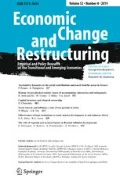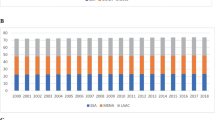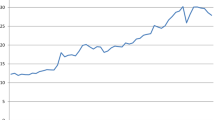Abstract
This paper provides an overview of changes in Latin American trade regime. The inward-looking import substitution industrialization (ISI) approach to development was replaced in the 1990s by an outward-looking strategy. The protectionist policies of the ISI strategy generated an anti-export bias, but unilateral trade liberalization (UTL) reduced this bias considerably. An issue discussed is why the pro-ISI consensus of the 1960s was replaced by the pro-export consensus of the 1990s? There has been a surprising proliferation of (bilateral) free trade agreements (FTAs) during the 1990s. In the paper it is argued that UTL and FTAs are complementary strategies. Latin America has comparative advantages in natural resources. A new debate over the development strategy has emerged. Information and communication technologies (ICT) are seen as crucial to a country’s growth in the twenty-first century. So, how can Latin American countries incorporate such technologies into their economies. Is it possible to make the leap from producing natural resources to producing ICT? In today’s globalized world, it is essential for Latin American countries to increase its exports. This paper reviews actions on different fronts; some that should be carried at the domestic level, and also, measures at the external level which require that the developed countries provide better market access to Latin American exports.
Similar content being viewed by others
Notes
This excludes the special case of Venezuela.
In the Chilean case, trade reform in the 1970s have resulted in the loss of around 10% of all manufacturing jobs (see Meller 1992).
In making this statement, one is implicitly assuming that different countries are homogeneous in size and per-capita income.
If raw materials represent one-third of the final price of the good, and (these raw materials) have zero tariff, the effective rate of protection of the final good would be 50% higher than the nominal tariff (of the final good).
The French newspaper Le Canard Enchané (June 4, 2003) provides the following numbers: European cows receive two euros per day provided by EU Government subsidies; three billion people of developing countries live with two euros per day.
References
Auboin M, Laird S (1999) How important are trade defensive measures and non-tariff barriers for LDCs—with particular emphasis on those of the EU? In: Memedovic O, Kuyvenhoven A, Molle WTM (eds) op.cit., pp 167–207
Auty RM, Mikesell RF (1998) Sustainable development in mineral economies. Clarendon Press, Oxford
Bekinschtein JA (1999) Discussion of Thorstensen and Félix Peña Paper. In: Memedovic O, Kuyvenhoven A, Molle WTM (eds) op.cit., pp 275–277
BID (2001) Competitividad. El Motor del Crecimiento, Progreso Económico y Social en América Latina, Informe 2001, Washington DC
Blinder A (1987) Hard heads, soft hearts. Addison-Wesley, Reading
CEPAL (2001) Panorama de la Inserción Internacional de América Latina y el Caribe, 1999–2000. CEPAL, Santiago
De Melo J, Panagariya A (eds) (1996) New dimensions in regional integration. Cambridge University Press, London
Devlin R, Estevadeordal A (eds) (2003) Bridges for development: policies and institutions for trade and integration. IDB, Washington, DC
Finger JM (2002) Safeguards: making sense of GATT/WTO provisions for import restrictions. In: Hoekman B, Mattoo A, English P (eds) op.cit., pp 195–205
International Monetary Fund (2002) World economic outlook. Washington, DC
Krueger A (1990) Asymmetries in policy between exportables and import-competing goods. In: Jones R, Krueger A (eds) The political economy of international trade. Blackwell, Cambridge
Krugman P (1991) Geography and trade. MIT Press, Cambridge
Meller P (1992) La apertura comercial chilena: lecciones de política, Red de Centros del BID, enero, Washington DC
Meller P (ed) (1996) Un Siglo de Economía Politíca (1890–1990). Andrés Bello, Santiago
Meller P (2003) A developing country view on liberalization of tariff and trade barriers, Presentation at the OECD global forum on trade “Moving forward on market access in the DOHA development agenda”, Paris, June 5–6
Memedovic O, Kuyvenhoven A, Molle WTM (1999) Multilateralism and regionalism in the Post-Uruguay round era. What role for the EU? Kluwer Publisher, London
Muñoz O (2001) Estrategias de Desarrollo en Economías Emergentes. Flacso, Santiago
Paiva Abreu M (2004) The FTAA and the political economy of protection in Brazil and USA. Working paper INTAL-BID, Buenos Aires
Rodrik D (1992) The rush to free trade in the developing world: why so late, why now? will it last? Working paper no. 3947, N.B.E.R., enero
Sachs JD, Warner AM (1995) Natural abundance and economic growth. NBER working paper no: W5398, Cambridge
Thorstensen V, Peña F (1999) The view from Latin America. In: Memedovic O, Kuyvenhoven A, Molle WTM (eds) op.cit., pp 235–274
Williamson J (ed) (1990) Latin American adjustment: how much has happened? Institute for International Economics, Washington, DC
World Bank (2001) From natural resources to the knowledge economy. World Bank Latin American and Caribbean Studies, Washington DC
Author information
Authors and Affiliations
Corresponding author
Rights and permissions
About this article
Cite this article
Meller, P. From unilateral liberalization to regional free trade agreements: a Latin America perspective. Econ Change Restruct 42, 85–103 (2009). https://doi.org/10.1007/s10644-008-9061-5
Published:
Issue Date:
DOI: https://doi.org/10.1007/s10644-008-9061-5




